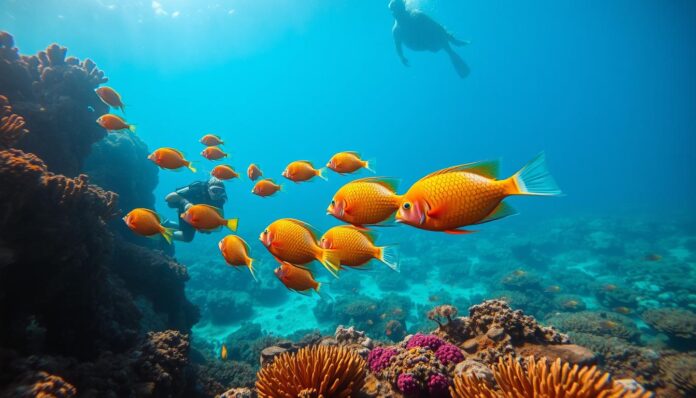Did you know parrotfish create 80% of the sand on tropical beaches? They make about 1 ton of sand every year. This changes the underwater world in amazing ways.
Scuba diving with parrotfish is an incredible adventure. It shows the colorful world of tropical dive locations. There are about 80 different kinds of parrotfish, making them more than just pretty fish.
Parrotfish can grow up to 1 meter long. Their social lives are complex and interesting. Imagine diving in clear waters with schools of 40 parrotfish.
Key Takeaways – Diving with Parrotfish
- Parrotfish generate most of the sand on tropical beaches
- There are 80 unique species of parrotfish
- Scuba diving reveals their fascinating underwater behaviors
- Tropical dive locations offer incredible parrotfish encounters
- These fish play a critical role in marine ecosystems
Introduction to Scuba Diving with Parrotfish
Dive into the vibrant underwater world of parrotfish. These colorful fish are key to coral reef ecosystems. They are not just beautiful but also vital to the marine environment’s balance.
What Makes Parrotfish Unique?
Parrotfish are truly marine marvels. With about 80 species, they have amazing features. These include:
- Distinctive beak-like mouths used for scraping algae from coral
- Ability to change sex multiple times throughout their lives
- Vibrant colors ranging from electric blues to brilliant greens
The Importance of Coral Reefs
Parrotfish behavior is key to healthy coral reefs. They do several important things:
- Produce approximately 80% of sand found on tropical beaches
- Generate up to 1 ton of sand per year
- Control algae growth that could suffocate coral formations
“A single parrotfish can create hundreds of kilograms of sand annually, reshaping tropical coastlines.”
Destinations for Parrotfish Sightings
Several amazing locations offer great parrotfish sightings. Beqa Lagoon in Fiji is one such place. Here, you can see Bicolor, Stoplight, Queen, and Rainbow Parrotfish.
Whether you’re a seasoned diver or just curious, learning about parrotfish will change your underwater adventures.
The Basics of Scuba Diving
Exploring the underwater world needs careful preparation and knowledge. It’s important for both beginners and experienced swimmers. Knowing the basics of scuba diving is key for a safe and fun dive.
Essential Gear for Your Underwater Adventure
Before diving into the world of parrotfish, you must know the essential scuba diving gear. Dive equipment rental services offer everything needed for a successful dive.
- Mask for clear underwater vision
- Fins for efficient swimming
- Wetsuit for temperature protection
- Buoyancy Compensator Device (BCD)
- Regulator for breathing underwater
- Air tank for oxygen supply
Scuba Diving Certifications
Getting a scuba certification is vital for safe diving. There are different levels of certification to fit your skill and comfort:
| Certification Level | Depth Limit | Training Required |
|---|---|---|
| Open Water Diver | 18 meters (60 feet) | 4-5 days |
| Advanced Open Water | 30 meters (100 feet) | 2-3 days |
| Rescue Diver | 40 meters (130 feet) | Additional rescue skills training |
Safety Tips for Beginners
Diving can be amazing when you focus on safety. Always dive with a certified instructor. Make sure your equipment is in good shape and follow these important tips:
- Never dive alone
- Check equipment before entering water
- Maintain proper breathing techniques
- Stay within your certification limits
- Monitor air supply constantly
“The sea, once it casts its spell, holds one in its net of wonder forever.” – Jacques Cousteau
With the right preparation, scuba certification, and knowledge of dive equipment rental, you’re set to explore the underwater world of parrotfish and more.
Ideal Locations for Parrotfish Diving
Finding the best places for parrotfish diving takes research and insider tips. Parrotfish lovers can enjoy amazing underwater adventures worldwide. Some spots are known for their incredible marine life.
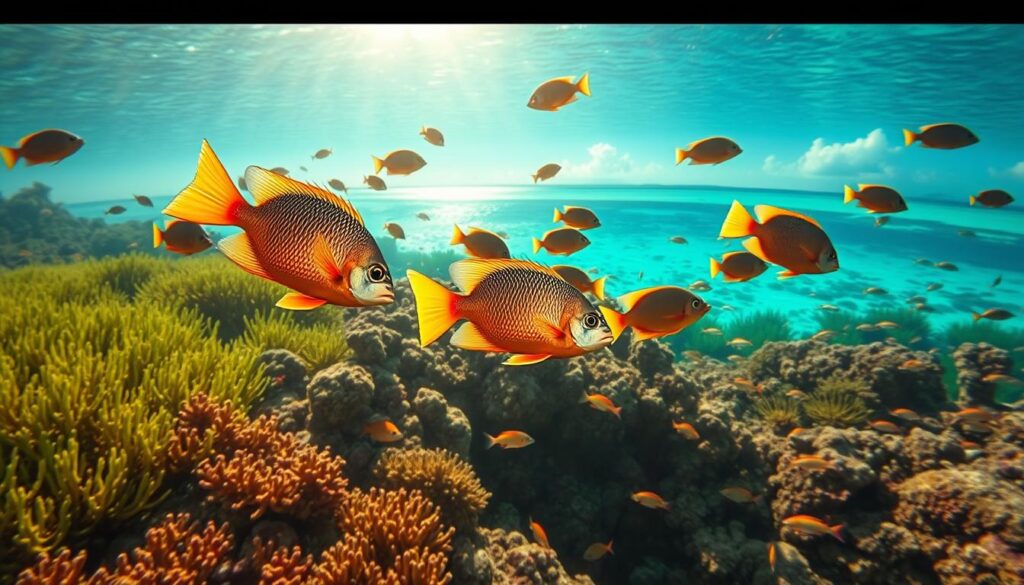
Asia:
- Maldives: With its crystal-clear waters and pristine coral reefs, the Maldives is a dream destination for diving with parrotfish. Explore sites like Maaya Thila and Banana Reef, where parrotfish thrive amidst a backdrop of colorful corals and an abundance of marine life.
- Indonesia: The Indonesian archipelago is renowned for its incredible marine biodiversity. Destinations such as Raja Ampat, Komodo National Park, and Bali offer exceptional diving experiences, allowing divers to encounter a variety of parrotfish species alongside other fascinating marine creatures.
- Egypt: The Red Sea coast of Egypt is a treasure trove for divers. Destinations like the Sinai Peninsula, including Sharm El Sheikh and Dahab, provide access to thriving coral reefs where parrotfish can be spotted gliding through the turquoise waters.
- Seychelles: The Seychelles boasts a range of marine protected areas and stunning coral reefs. Praslin, La Digue, and the Aldabra Atoll are popular dive spots where parrotfish can be observed alongside an array of other marine species, including turtles and rays.
- Bonaire: Known as a diver’s paradise, Bonaire in the Dutch Caribbean offers exceptional diving opportunities. The island’s marine park, Bonaire National Marine Park, is home to abundant parrotfish populations. Explore sites like the famous Salt Pier and the vibrant reefs of Klein Bonaire.
- Cayman Islands: The Cayman Islands, including Grand Cayman, Cayman Brac, and Little Cayman, are renowned for their stunning dive sites. The crystal-clear waters reveal a diverse underwater world, with parrotfish sharing the reefs with other colorful marine species like angelfish and butterflyfish.
- Belize: The Belize Barrier Reef, a UNESCO World Heritage Site, is a must-visit destination for diving enthusiasts. Explore sites like the Great Blue Hole and Glover’s Reef Atoll, where parrotfish can be found among a kaleidoscope of coral formations and an abundance of marine life.
- Roatán, Honduras: Roatán, the largest of the Bay Islands in Honduras, offers excellent diving opportunities. Encounter parrotfish while exploring the vibrant coral gardens of the Mesoamerican Barrier Reef System, the second-largest barrier reef in the world.
- Maltese Islands: The Maltese Islands, located in the Mediterranean Sea, offer diverse diving experiences. Explore the crystal-clear waters surrounding Gozo and Comino, where parrotfish can be found alongside fascinating underwater caves, rock formations, and wrecks.
- Great Barrier Reef, Australia: The Great Barrier Reef is a UNESCO World Heritage Site and the world’s largest coral reef system. Dive at locations like the Ribbon Reefs and the Cod Hole to witness the impressive biodiversity and encounter parrotfish in their natural habitat.
- Fiji: The tropical paradise of Fiji is renowned for its breathtaking dive sites. Beqa Lagoon, Taveuni, and the Yasawa Islands offer spectacular diving experiences where divers can swim alongside parrotfish, surrounded by vibrant coral gardens and an abundance of marine life.
- Florida Keys, USA: The Florida Keys, stretching from Key Largo to Key West, offer exceptional diving opportunities. Explore the coral reefs of the Florida Keys National Marine Sanctuary, where parrotfish coexist with a multitude of marine species, including turtles, stingrays, and nurse sharks.
- Galápagos Islands, Ecuador: The Galápagos Islands are a bucket-list destination for divers seeking unique encounters with marine life. Swim alongside parrotfish while exploring the volcanic formations and diverse ecosystems that inspired Charles Darwin’s theory of evolution.
Each of these destinations offers a unique diving experience with parrotfish and an abundance of other marine species. Remember to plan your dives carefully, respect local regulations, and follow sustainable diving practices to ensure the preservation of these fragile ecosystems.
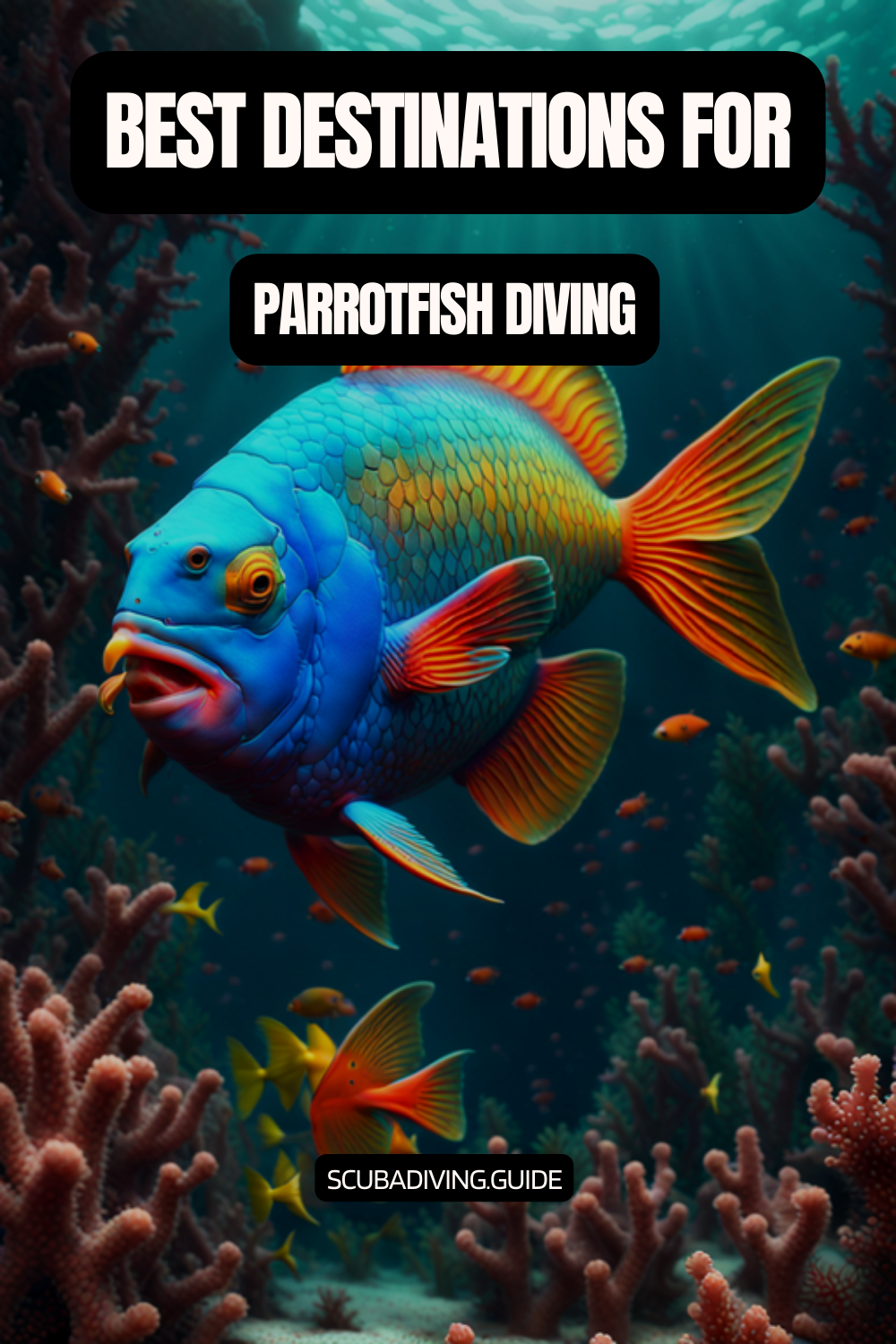
Hidden Gems for Adventurous Divers
Raja Ampat in Indonesia is a hidden gem for daring divers. It’s famous for:
- Large schools of green humphead parrotfish
- Peak diving season from October to April
- Extraordinary marine biodiversity
“Raja Ampat represents the pinnacle of underwater exploration for passionate divers.” – Marine Expedition Magazine
Whether you dive from the shore or go on a liveaboard, these places offer unforgettable parrotfish encounters.
The Experience of Diving with Parrotfish
Diving into the underwater world of parrotfish is an amazing experience. It shows a vibrant ecosystem full of life and color. These creatures give divers a special look into coral reef environments.
What to Expect Underwater
Get ready for an immersive dive where parrotfish behavior is the main attraction. Divers will see schools of hundreds of parrotfish moving together. Photography lovers will find many chances to capture these marine wonders.
- Observe large schools of parrotfish moving in coordinated patterns
- Witness feeding behaviors on algae-covered reef surfaces
- Experience the dynamic interactions within parrotfish communities
Parrotfish Behavior and Habitats
Parrotfish are key to reef ecosystems. They eat up to 20% of their body weight in algae daily. This helps control reef vegetation. They have unique traits like:
| Characteristic | Details |
|---|---|
| Sand Production | Can generate up to 1,000 kg of sand annually |
| Size Range | 35-80 cm depending on species |
| Lifespan | 5-7 years in typical habitats |
Close Encounters: Capturing Memories
Underwater photography needs patience and respect for marine life. Parrotfish offer great photo opportunities, like during feeding and schooling. Night dives add more mystery, with about 80% of parrotfish sleeping in protective mucus cocoons.
“In the realm of underwater exploration, parrotfish represent nature’s living artwork, constantly reshaping coral landscapes with every passing moment.” – Marine Biologist Research Team
With about 95 species worldwide, each dive is a chance to meet these amazing creatures.
Environmental Considerations
Diving into the underwater world shows us a delicate ecosystem. It needs our respect and protection. Marine conservation is more than a concept; it’s a mission to keep coral reefs and marine life healthy.
Protecting Coral Reefs: A Crucial Mission
Parrotfish are key to keeping coral reefs healthy. They eat algae that could harm corals, helping to protect marine habitats. A single bumphead parrotfish can eat up to 5 tons of reef carbonates each year.
- Bumphead parrotfish are classified as ‘vulnerable’ on the IUCN Red List
- They can grow up to 130 cm and live for 40 years
- These fish form social groups of 20 to 100 individuals
Responsible Diving Practices
Scuba divers have a big responsibility to protect the ocean. Every time we interact with marine life, we must be careful and aware.
“We do not inherit the ocean from our ancestors; we borrow it from our children.” – Unknown Marine Conservationist
Joining Conservation Efforts
There are many ways to help with marine conservation. Here are a few:
- Supporting local marine protection initiatives
- Choosing eco-friendly dive operators
- Spreading awareness about reef ecosystem importance
- Participating in citizen science projects
Programs like the Caribbean Marine Biodiversity Program show how teamwork can protect marine environments. They help protect species like parrotfish.
Best Times to Dive for Parrotfish
Timing is key when diving to see parrotfish in tropical waters. Knowing when and why they behave certain ways can make your dive unforgettable.
Seasonal Changes and Fish Behavior
Parrotfish have interesting habits all year. Bumphead parrotfish gather in huge numbers for mating. These events happen every month, with groups of up to 15 fish.
- Monthly spawning aggregations during new moon phases
- Spawning events lasting approximately 45 minutes
- Potential to observe massive groups of 2,000 individuals
Weather Considerations for Night Dives
Night dives let you see parrotfish in their nighttime world. Some species hide in a protective mucus cocoon to avoid predators like moray eels.
“The ocean reveals its secrets only to those patient enough to observe.” – Marine Biologist Sarah Thompson
Optimal Water Temperatures
Water temperature affects parrotfish activity. Diving in waters between 75-82°F is best for them. Plan your dive during the peak seasons for the best experience.
| Location | Best Months | Water Temp (°F) |
|---|---|---|
| Caribbean | December-April | 78-82 |
| Great Barrier Reef | June-August | 75-80 |
| Palau | Year-round | 79-84 |
Get ready for an amazing dive by choosing the perfect time and place for your parrotfish adventure!
Wildlife Interactions While Diving
Diving into the underwater world offers more than just a glimpse of parrotfish. Coral reef exploration reveals a vibrant ecosystem teeming with diverse marine life. This will captivate your imagination and spark your sense of wonder.
Marine Life Beyond Parrotfish
During your underwater adventure, you’ll encounter an incredible array of sea creatures. Marine conservation efforts have helped preserve these rich habitats. This allows divers to witness spectacular wildlife interactions.
- Sea turtles gliding gracefully through crystal waters
- Manta rays with wingspans up to 23 feet
- Playful dolphins in tropical marine environments
- Whale sharks measuring up to 40 feet in length
Respecting the Underwater Ecosystem
Responsible diving means maintaining a respectful distance from marine life. Observe but do not disturb is the golden rule of underwater exploration. Each creature plays a critical role in the delicate balance of coral reef ecosystems.
“The ocean is a magical place where every creature has a story to tell.” – Marine Biologist
Educational Opportunities
Every dive is a chance to learn about marine biodiversity. By understanding the relationships between different species, divers become ambassadors for marine conservation. They help protect these incredible underwater environments for future generations.
- Learn about symbiotic relationships
- Understand marine species behavior
- Contribute to scientific research
- Raise awareness about ocean preservation
Planning Your Diving Adventure
Getting ready for an amazing underwater trip needs careful planning. Divers wanting to see colorful sea life should know about renting dive gear and liveaboard diving.
Choosing the Right Dive Shop
Finding a good dive shop is key for a fun and safe dive. Look for shops with:
- Certified and experienced instructors
- Well-maintained dive equipment rental services
- Comprehensive safety briefings
- Small group sizes for personalized attention
Understanding Dive Packages
Dive packages vary, meeting different needs and skill levels. Liveaboard diving lets you dive often in beautiful spots.
| Package Type | Duration | Typical Dives per Day |
|---|---|---|
| Day Trip | 1-2 days | 2-3 dives |
| Liveaboard | 3-7 days | 4-5 dives |
Transportation and Accommodations
Think about how close you are to dive spots and your comfort. Liveaboard diving solves travel issues by taking you straight to the best spots.
“The ocean stirs the heart, inspires the imagination and brings eternal joy to the soul.” – Robert Wyland
Look into dive spots with full packages. These include dive equipment rental, places to stay, and lots of diving chances.
Preparing for Your Dive
Getting ready for a dive into the world of parrotfish is key. Your journey starts long before you dive, with planning and getting ready being very important. These steps help make sure your dive is safe and fun.
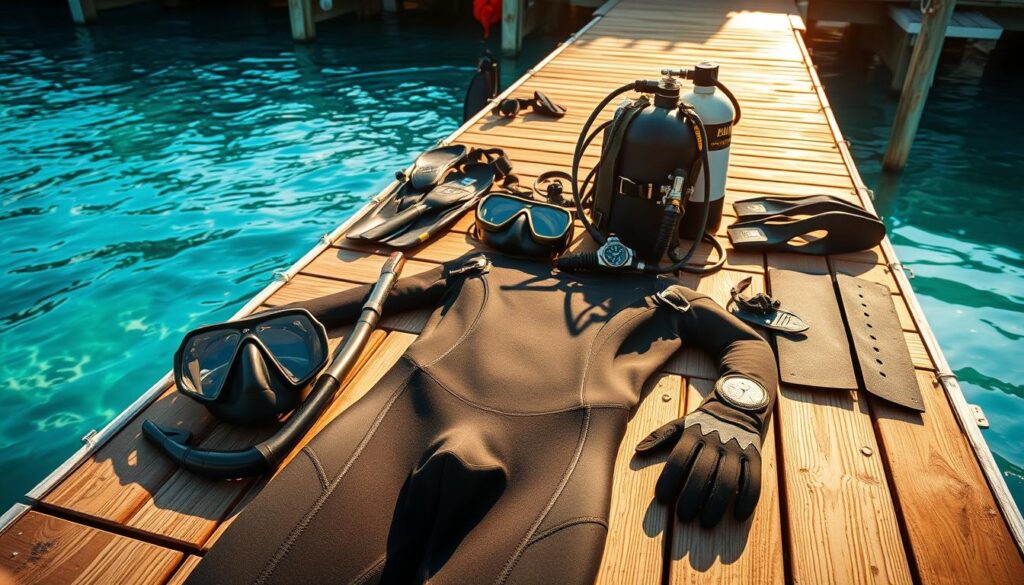
Pre-Dive Briefing Tips
A good pre-dive briefing is the first step to a great dive. In this session, you’ll learn about:
- Dive site specific conditions
- Marine life interactions
- Safety protocols
- Equipment communication signals
Physical Fitness and Health Assessments
Scuba certification is not just about knowing the rules. Being physically fit is also very important for your safety. Here are some health factors to consider:
- Cardiovascular endurance
- Swimming proficiency
- Lung capacity
- Medical clearance from a professional
“Your body is your most important dive equipment” – Professional Diving Instructor
Mental Preparation for the Dive
Having the right mindset for your dive can change your experience. Calm, focused preparation helps deal with any nerves and makes the dive more enjoyable. Deep breathing and visualization can boost your confidence when renting equipment and diving.
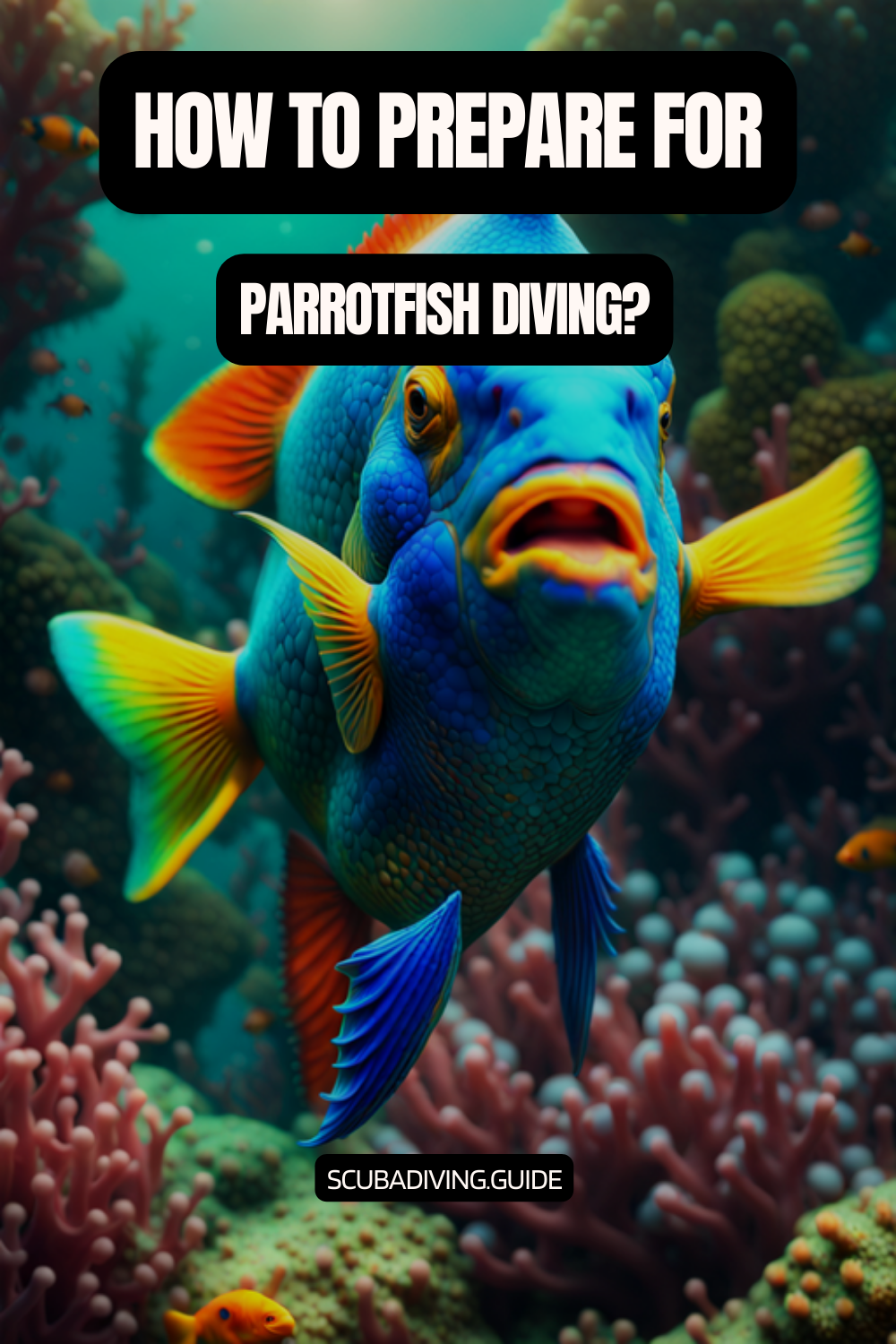
If you’re new to diving, don’t worry. Professional dive centers are there to help. They can guide you through scuba certification and offer advice on choosing equipment and getting mentally ready.
Common Marine Species Found Alongside Parrotfish
Diving with parrotfish offers not only the opportunity to observe these fascinating creatures but also to encounter a diverse array of marine species that share their habitat. The coral reefs where parrotfish thrive are teeming with life, and here are some of the common marine species you may encounter during your dives:
- Clownfish: These iconic fish, also known as anemonefish, are often found alongside parrotfish in their shared coral reef homes. Known for their striking colors and unique relationship with sea anemones, clownfish captivate divers with their playful behavior and intricate social structure.
- Butterflyfish: Graceful and vibrant, butterflyfish add elegance to the underwater scene. With their flat bodies and fluttering movements, they navigate through coral formations with ease. Their colorful patterns and elongated snouts make them a captivating sight alongside parrotfish.
- Angelfish: Angelfish are another common sight in the presence of parrotfish. With their striking patterns and graceful movements, these fish add beauty to the reef. From the majestic Emperor Angelfish to the vibrant Flame Angelfish, encountering these creatures adds excitement to any dive.
- Moray Eels: Slithering through crevices and coral structures, moray eels are often found alongside parrotfish. Despite their fearsome appearance, these elongated creatures are generally not aggressive unless provoked. Observing their mesmerizing movements and the opening and closing of their mouths reveals a glimpse into their fascinating behavior.
- Triggerfish: Known for their bold personalities and distinct shapes, triggerfish are frequently encountered alongside parrotfish. These fish exhibit intriguing behaviors such as nest building and territorial defense. Divers should approach triggerfish with caution, especially during their breeding season, as they may become more aggressive.
- Cleaner Shrimp: Cleaner shrimp provide a valuable service to the underwater community by removing parasites and debris from the bodies of other fish. Divers often encounter these small, curious creatures near cleaning stations, where larger fish visit to have their bodies cleaned by the diligent shrimp.
- Hawksbill Turtles: The graceful presence of hawksbill turtles adds a touch of wonder to any dive. These endangered creatures are commonly seen swimming alongside parrotfish, gracefully gliding through the water or leisurely resting on coral ledges. Observing these gentle giants evokes a sense of awe and emphasizes the importance of marine conservation efforts.
- Surgeonfish: Recognizable by their sharp spines and vibrant colors, surgeonfish are frequently found in the company of parrotfish. These fish play an essential role in reef ecosystems by grazing on algae, contributing to the overall health and balance of the coral reef. The Yellow Tang and the Palette Surgeonfish (also known as the Blue Tang) are popular species in this group.
Encountering these common marine species alongside parrotfish enhances the overall diving experience, offering a glimpse into the interconnected web of life within coral reef ecosystems. Remember to observe these species with respect, maintaining a safe distance and minimizing any disturbances to their natural behavior.
Conclusion: Embrace the Adventure
Scuba diving with parrotfish takes you deep into marine ecosystems. You’ll see vibrant waters in the Andaman archipelago and tropical reefs around the world. These colorful fish are key to underwater conservation.
Parrotfish help keep coral reefs healthy. With over 1,500 fish species, they play a big role in marine environments.
Scuba diving with parrotfish is more than just watching them. It’s a chance to connect with marine conservation. Studies show 80% of divers see the value of underwater photography in protecting marine life.
By diving responsibly, you help protect these delicate habitats. This is important for the health of our oceans.
Marine conservation needs everyone’s help. About 70% of dive centers join in by restoring coral and cleaning up underwater. Your dives can help protect these amazing places and the creatures that live there.
Think about your dive and how it’s more than fun. It’s a chance to care for our planet’s oceans. Dive with respect, explore with wonder, and keep learning about the underwater world.
FAQ – Diving with Parrotfish
What makes parrotfish so unique?
Parrotfish stand out with their bright colors and beak-like mouths. They are key to coral reefs, helping to create sandy beaches. This makes them vital to marine life.
Do I need special certification to dive with parrotfish?
You don’t need a special parrotfish certification. But, having an Open Water Diver certification is a good idea. It ensures you’re safe and confident underwater.
Where are the best locations to see parrotfish?
The Caribbean, Great Barrier Reef, and Hawaii are top spots. Places like the Cayman Islands, Belize, and the Maldives are also great. They offer a chance to see parrotfish in their natural home.
What equipment do I need for parrotfish diving?
You’ll need a mask, fins, wetsuit, and a BCD. Also, a regulator, dive computer, and camera are good to have. Many dive shops rent out equipment.
Are parrotfish dangerous to divers?
No, parrotfish are not dangerous. They are peaceful, grazing on coral and algae. They are curious but not aggressive, making them great for underwater photos.
When is the best time of year to dive with parrotfish?
The best time varies by location. Dry seasons with calm waters are best. In the Caribbean, dive from December to April. The Great Barrier Reef is great from June to November.
How can I help protect parrotfish and their habitat?
Dive responsibly by keeping a safe distance and not touching coral. Use reef-safe sunscreen and support marine conservation. Choose eco-friendly dive operators and join conservation efforts.
Can I take photos of parrotfish underwater?
Yes, underwater photography is a great way to capture parrotfish. Use a camera with good low-light performance. Take a course to improve your skills. Approach slowly and avoid disturbing the fish.
Are night dives good for seeing parrotfish?
Night dives are special for seeing parrotfish. They sleep in protective mucus cocoons. It’s a rare sight, making night dives an extraordinary experience.
What should I know about parrotfish conservation?
Parrotfish are vital to coral reefs but face threats. Overfishing, habitat destruction, and climate change are dangers. Support marine protected areas and practice responsible diving to help protect them.
